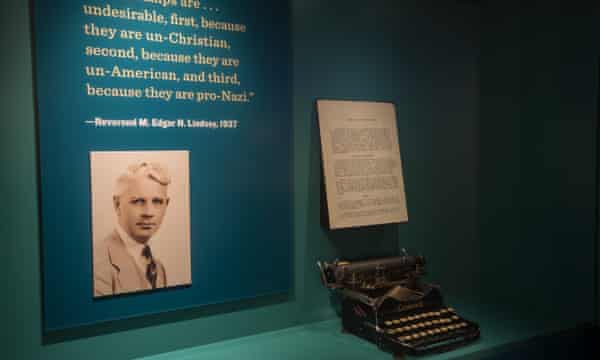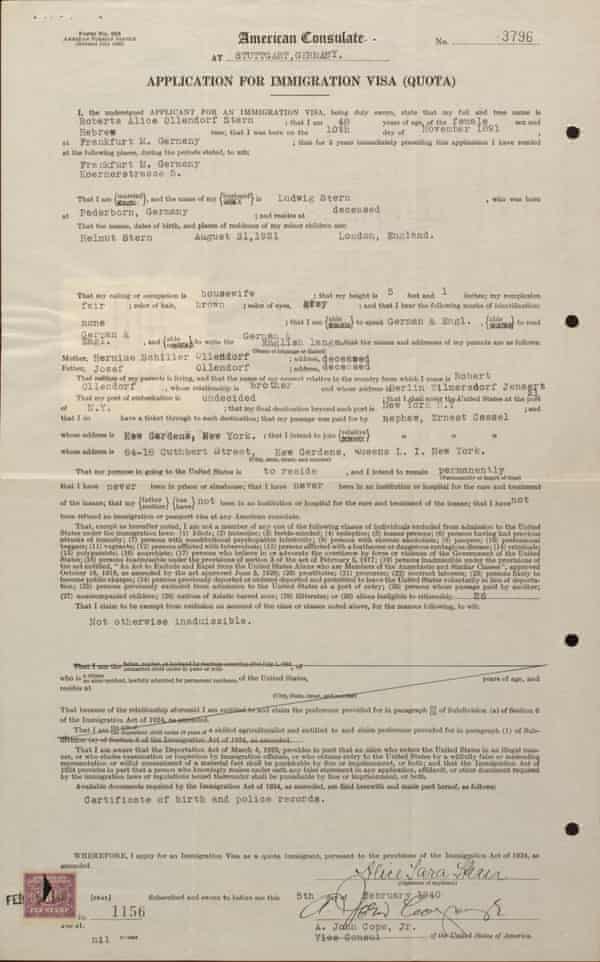what motives shaped americans’ responses to nazism, war, and genocide?
What did they know and when did they know it? And why didn't they exercise more to end it?
The motives, pressures and fears that shaped America's response to the murder of vi 1000000 Jews in Europe during the 1930s and 1940s are the subject field of a provocative new exhibition at the Us Holocaust Memorial Museum in Washington DC.
Americans and the Holocaust debunks the myth that Americans lacked access to information almost the persecution of Jews as it was happening, demonstrates that they had fiddling appetite to take in refugees from Europe and illustrates that President Franklin Roosevelt's main focus was on winning a war, not catastrophe a genocide.
"We show how Americans' isolationism after world war one, our own xenophobia, racism and antisemitism, and so the catastrophe of the Great Depression, an economical crisis, shape Americans' responses to nazism," said exhibition curator Daniel Greene. "Americans had a lot of information about the threat of nazism in real fourth dimension including, after 1942, murder of Jews across Europe, and we want visitors to ask why rescue of Jews didn't become a priority."

The alarm signs were there. In the 1930s, the exhibition recounts, popular US news magazines reported almost weekly on Hitler and Nazi Deutschland, including the targeting of Jews, communists and other political opponents. 1 striking display includes Fourth dimension magazine covers featuring Hitler and propaganda minister Joseph Goebbels, a Newsweek embrace dominated by Hitler at a Nazi rally and a Vanity Fair cover with a caricature of Hitler superimposed on a giant swastika.
No less fascinating is a Cosmopolitan magazine from March 1932 in which American journalist Dorothy Thompson interviews Hitler. The article begins: "When I walked into Adolf Hitler's salon, I was convinced that I was meeting the future dictator of Federal republic of germany. In less than 50 seconds I was sure I was not. Information technology took just that time to measure out the startling insignificance of this human who has set the world ardent."
But Thompson likewise observed: "Antisemitism is the life and soul of Hitler's motion. The Nazis lose no opportunity to insult the Jews."
A digital touchscreen brandish of a US map allows visitors to tap whatsoever state and see how regional newspapers of the fourth dimension were also sounding the alarm. On 29 March 1933, for example, the Dallas Morning News carried a front end page headline: "Nazi Chiefs Lodge Jewish Boycott; Even School Children Are Included."

Greene said: "The media landscape of the 1930s and 40s includes newspapers, magazines, newsreels, radio, and right across all this media we see that Americans could have had admission to information about the threat of Nazis if they were paying close attention. 1 of the things we actually want people to empathise is it's not a story that you only had if y'all were on the coast or in a big metropolitan urban center. Across the country Americans could read nearly the threat of nazism."
In the bound of 1933, the exhibition records, tens of thousands of Americans signed petitions protesting the Nazis' treatment of Jews, only the US made no official argument against the High german regime. In June that year, Roosevelt said: "The German authorities are treating the Jews shamefully and the Jews in this country are greatly excited. But this is also not a government affair."
In 1938 Kristallnacht, or the Night of Broken Drinking glass, which saw coordinated attacks on thousands of synagogues and Jewish businesses across Frg, made imprint headlines on front end pages from Atlanta to Philadelphia to San Francisco. Roosevelt, who told a press briefing that it had "deeply shocked" the American public, was asked by a reporter: "Would you recommend a relaxation of our immigration restrictions so that Jewish refugees could be received in this country?" The president replied: "This is non in contemplation; we take the quota arrangement."
Roosevelt'southward legacy in relation to refugees has come under increasing scrutiny in contempo years, but the exhibition is fifty-fifty-handed. Greene said: "I of the things I've thought well-nigh here is when does a president endeavour to lead public opinion and when does he follow information technology. Then public stance is against entering into the war but Roosevelt tries to atomic number 82 information technology towards intervention. Public opinion is very much against letting in refugees and he decides that'southward not what he's going to spend his political majuscule on.
"Roosevelt is a political animal and he'southward always making decisions based on politics. Part of politics is thinking near popularity and what do the American people remember, and the American people at this time are clear nigh what they think about albeit refugees."
Opinion polls several weeks after Kristallnacht constitute that 94% of Americans disapproved of the Nazi treatment of Jews, simply 71% did not want more Jewish refugees to come to the U.s.a..

Americans and the Holocaust has stories of heroic individuals who went against the grain to rescue Jews from Europe, but also of Yale University students who founded the America Starting time Commission to oppose US intervention in the second world war. They won the back up of aviator Charles Lindbergh, who in a oral communication in Iowa in 1941 accused Jews of existence "war agitators". Lindbergh's 1941 diary and an insignia given to him on Hitler'south behalf for services to world aviation are on display.
America entered the war and Hollywood got on lath. But popular films of the era emphasised the fight for democracy rather than nazism's victims. Fifty-fifty Casablanca, starring Humphrey Bogart and Ingrid Bergman, depicted stranded refugees without mentioning Jews explicitly, though manager Michael Curtiz and several supporting players were Jewish. An exception was The Dandy Dictator with Charlie Chaplin, one of whose costumes is on show.
The killing continued on an industrial scale and past December 1942, radio broadcaster Edward Murrow was clear: "What is happening is this: millions of human beings, nigh of them Jews, are being gathered up with ruthless efficiency and murdered." But the U.s.a. authorities's priority was the defeat of nazism. It rejected pleas to flop rail lines that transported Jews to Auschwitz-Birkenau, its gas chambers or the entire camp every bit "impracticable" and a "diversion" from winning the war.
By 1945, as the Nazis collapsed, American magazines ran some of the first widely circulated photographs from concentration camps. On 7 May, Life stated: "For 12 years since the Nazis seized power, Americans have heard charges of German brutality … Terminal week Americans could no longer doubt stories of Nazi cruelty. For the first fourth dimension at that place was irrefutable evidence."
Greene said: "What you're seeing in a lot of the media in the 30s and 40s is information, but words. It's really April and May 1945 that you start to meet, in our mass media, visual evidence of the atrocities. And it does make me wonder if, in the 1940s, we can say seeing is believing and so Americans have of a lot of information merely they don't fully believe."
Fifty-fifty then, the needle barely moved. In a Dec 1945 poll, 69% of people said the US should admit the same or fewer people from Europe each twelvemonth than it did before the war. Only five% said it should admit more.
Source: https://www.theguardian.com/world/2018/apr/29/us-holocaust-memorial-museum-exhibition-americans-and-the-holocaust
0 Response to "what motives shaped americans’ responses to nazism, war, and genocide?"
Enviar um comentário